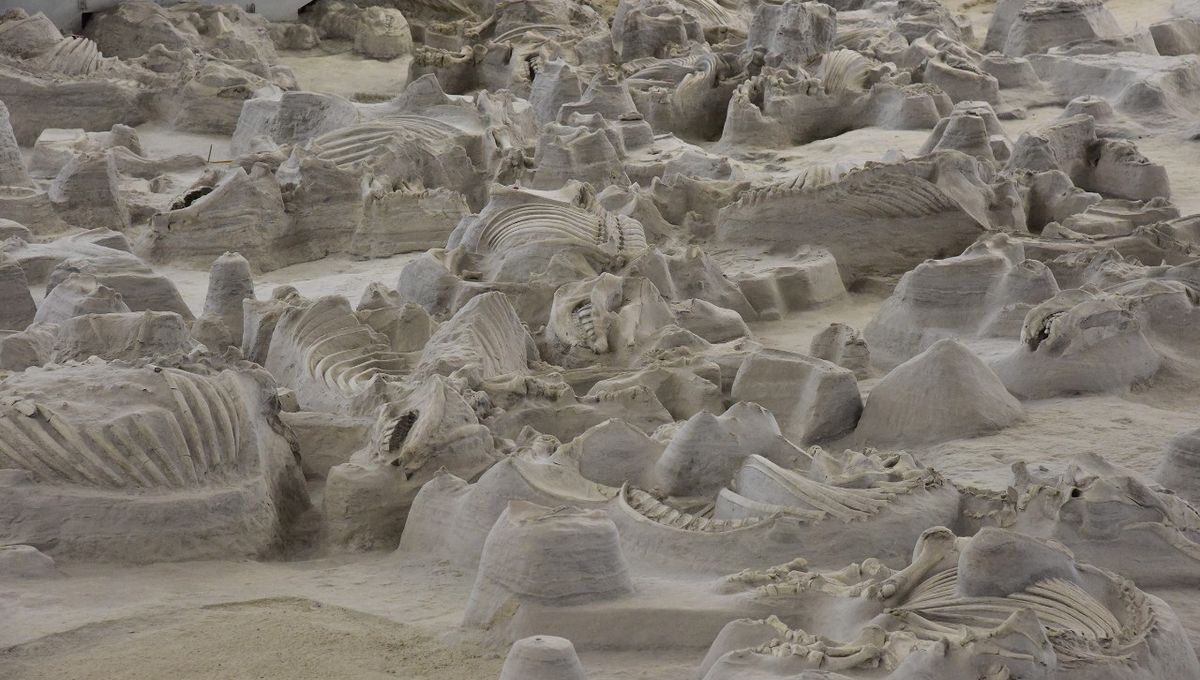
A tragic accident that befell ancient rhinos in the mid-Miocene era has allowed scientists to determine that these massive mammals, which once thrived across North America, used to gather in huge super-herds.
Around 12 million years ago, over 100 prehistoric rhinos (Teleoceras major) gathered at a single water hole in what is now northeast Nebraska. These one-horned animals had a barrel-shaped body and stubby legs, quite like a modern hippo. Also, like hippos, they fed on the grasses and may have spent long periods of time either in or around bodies of water.
While you may have a picturesque image in your mind, the lives of these particular rhinos were cut short after the Yellowstone supervolcano erupted and spewed out clouds of ash that eventually entombed them. As a result, the remains of these animals, as well as other species of mammals, became preserved in what is now known as the Ashfall Fossil Beds.
Since their discovery in 1971, researchers have been aware that there was an unusual number of rhinos found at this site. This has led to some speculation as to why so many animals were gathered together at the time of the eruption. Did they gather from far away, maybe to seek shelter from the effects of the eruption, or were they together for a different reason? Well, new analysis seems to suggest that something else was going on: the animals may have formed large herds instead.
“We found they didn’t move very much,” lead author and University of Cincinnati graduate Clark Ward explained in a statement.
“We didn’t find evidence for seasonal migration or any evidence of a response to the disaster.”
Ward analyzed isotopes – elements that have identical numbers of protons but different numbers of neutrons – in the rhinos’ teeth as part of a master’s research project overseen by Brooke Crowley at the University of Cincinnati and Professor Ross Secord, from the University of Nebraska. Together the team examined the ratio of isotopes of strontium, oxygen, and carbon in the teeth to assess the animal’s movements across their ancient landscape.
How can you tell where animals roamed based on this? Well, grass and leaves have similar isotopes as the soil and bedrock where they grow. So, if animals eat this vegetation, they ingest these isotopes, allowing researchers to determine where the animals fed. This form of analysis can be surprisingly precise, depending on how variable the vegetation and geology were.
The technique is used today for wildlife conservation, as it can help track the migration of wide-ranging animals, such as caribou. It can also help to identify the habitat needs of other elusive animals, like jaguars.
“By studying carbon in the animal, we can reconstruct carbon in the environment to understand what kinds of vegetation lived there,” Ward explained.
At the same time, oxygen can inform scientists about the surrounding climate, especially rainfall.
“We can use it to reconstruct how wet or dry the environment was,” Ward said. “And strontium tells us where the animal was foraging because the ratio of isotopes is related to the soil and supporting bedrock.”
T. major was a pretty large and chunky beast, so it had few natural predators. However, their young were vulnerable, especially when faced with bone-crushing dogs (Borophagus hilli). There is even evidence at the Ash Fall site that predators ate parts of their bodies after they died from the eruption.
Unlike the people killed when Vesuvius erupted, the rhinos that perspired at this site did not die quickly after the supervolcano erupted. Instead, they gradually succumbed to the flow of ash that traveled for hundreds of miles on the winds.
“That ash would have covered everything: the grass, leaves and water,” Ward added. “The rhinos likely weren’t killed immediately like the people of Pompeii. Instead, it was much slower. They were breathing in the ash. And they likely starved to death.”
Ward, who worked as an intern at Ashfall Fossil Beds State Historical Park, is now conducting PhD research at the University of Minnesota.
“I’m honored and privileged to have my name in science attached to the site,” Ward said. “As someone who used to go to Ashfall as a kid, it’s come full circle,” he said.
The paper is published in Scientific Reports.
Source Link: Ancient Rhinos Lived In Super-Herds 12 Million Years Ago, Analysis Of Supervolcano Victims Reveals